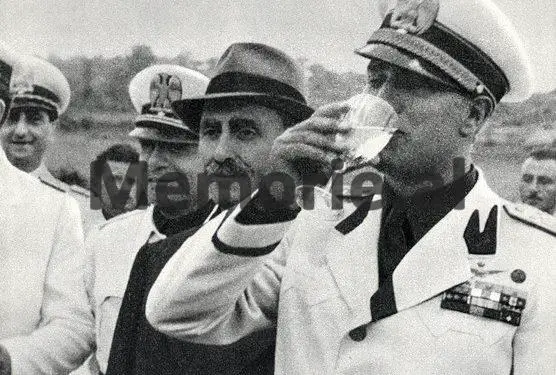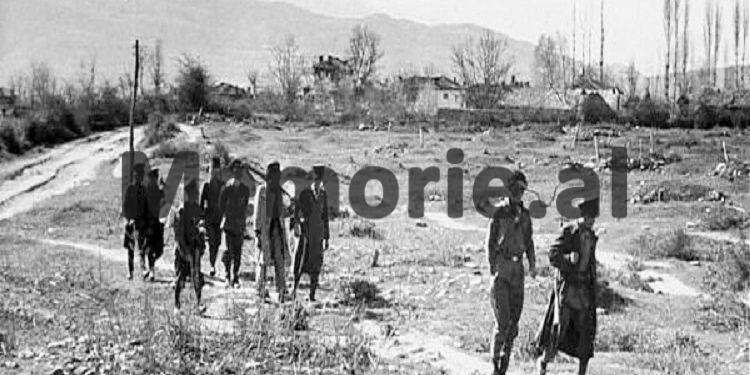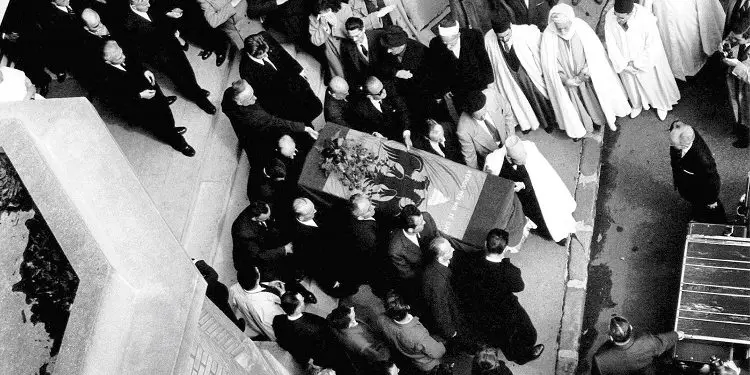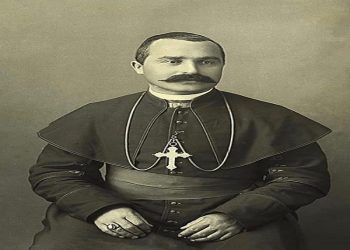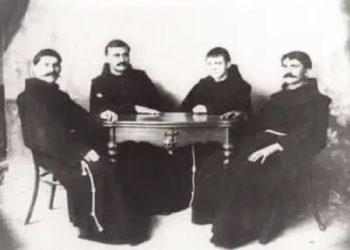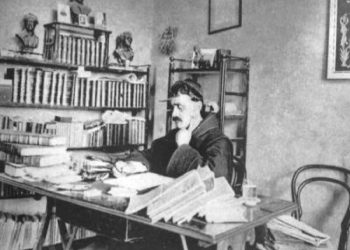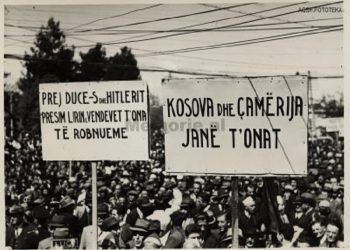By Eugen Shehu
Part Three
Memorie.al / It is almost like saying an axiom, the expressed opinion that history is the awake memory of a people! It never sleeps. It cannot sleep, otherwise it would be the death of the nation. This does not mean at all that there cannot be people who seek to kill history. On the contrary, they are in abundance and this was especially proven by the half-century-old Albanian dictatorship, which not only falsified and denigrated a relatively long period of the history of this century but, especially, tried to kill it. What weighs heavily in Albania, but also in Kosovo, Montenegro and Albanian Macedonia, was called the “Zog Period”, which was dressed by communist historiography, in all its blackness, as suited Slavic-Orthodox, Greek-Serbian-Bulgarian and Italian expansionism.
Continued from the previous issue
Education was also getting on track. In 1930, the Albanian government had entered into an agreement with the American philanthropic organization “Near East Foundation”, which was crowned with the construction of a model school in Golem of Kavaja for agricultural technology, because the great needs of Albania at that time were known. The school of the French Lyceum in Korça, meanwhile, has become one of the most famous in the Balkans. What attracts attention today is undoubtedly the constitutionalism of religious religions.
This constitution would curb the efforts of our enemy neighbors, who certainly in the absence of an attack on the borders, wanted to artificially incite war between our religious religions. It is interesting to know from Albanians (the miserable victims of communist historiography) that King Zog never collaborated with anyone to sell Albania, so even though the Italians provided a lot of assistance at these moments, they could not in any way compromise the royal court and the future of our nation.
It was King Zog himself who threw the Italian proposal for the customs union of the two countries into the wastepaper basket. He could foresee the legalized slavery in this case and also responded to the Italian tendencies in the structures of the Albanian army and gendarmerie. It was precisely these firm positions of King Zog that deeply irritated the Italian government that came to Durrës in the summer of 1934, the latter did not say that “Zog had been sold to Italy”, as had been written for 50 years in Albanian History.
But the fragile Albanian balances were threatened by even greater wars on the horizon. The signing of the Italo-German agreement, the so-called Rome-Berlin Axis, would naturally have its shocking consequences. Mussolini also signed with the British, who paradoxically recognized Italy’s right to Sovereignty over Ethiopia. In these circumstances, of course, King Zog could not rest on his laurels.
He had emphasized the need for vigilance, warning of the storms approaching the Adriatic. It is interesting to know at this time the definitions of Hugh Grant, former US minister in Albania, in those years, regarding King Zog; “In one of the audiences I had with him, in 1937, he warned me that a second world war would break out within two years. His prophecy was confirmed.
If Albania is known and considered by our State Department in Washington as a place of political observation in Europe, this can be largely attributed to the fact that King Zog was a keen student of international affairs and was well informed on the European political scene”. (Hugh Grant, ‘King Zog as I Knew Him’, p. 74).
The spring of 1939 would bring the only joy in the life of King Zog, forgotten in that turbulent course of the history of his people. In this spring, Mat’s son married Countess Geraldina Apponyj, who came from the distinguished Apponyj family of Hungary. Even in these few moments, King Zog would share his emotions and joys with his friends, sisters and relatives. A year later, a son would be born from this happy marriage. King Zog was already following the entire political situation in the Balkans and Europe.
With the same energy that he organized and led the state, he was always in the open heart of Albanianism. By his special decree, the Albanians of Chameria were settled in Vlora, Lushnje and Fier, just as by his order, hundreds of Albanian families in the lands enslaved by the Serbs-Slavs, forced by Serb-Slavic violence and terror, who emigrated to the mother country, were settled in Durrës and Kavajë. With funds from the Albanian state, land was bought for them and donated to them forever, thus warming their weary hearts.
Zogu showed the same care towards the National Army, inspecting it himself time and time again and providing concrete assistance. Meanwhile, seeing the “stubbornness” of the Albanian King, the Italians tried in several ways to overthrow the government and Ahmet Zogu himself. Things got there until the conspiracies followed one another.
In one of the last conspiracies, Ahmet Zogu was forced to expel from Albania Giovani Giro, who had organized dozens of young Albanians for the criminal act. Relations with Italy were also deteriorating because the latter had begun secret negotiations with the Yugoslavs.
In early 1939, Count Ciano (Mussolini’s son-in-law) went to Belgrade and, according to historiographical data, he spoke extensively with Stojadinović about the issue of the annexation of Albania. Of course, eventual military actions by Italy were viewed favorably by Belgrade, because in Albania there had always been a nationalist current that sought the unification of Kosovo with its own trunk.
Immediately after returning from Yugoslavia and after consultations with the Duce, Ciano presented King Zog with a document, supposedly for the further strengthening of relations between the two countries. In short, the content of this document clearly expresses the enslaving chain that the Italians wanted to put around the necks of the Albanians.
Giano’s eight proposals included:
1- The conclusion of a defensive alliance only with Italy.
2- The promise of Italian military assistance in the event of an external threat to Albanian territory.
3- Allowing the Italian government to intervene in the restoration of public order.
4- Concession to the Italian state to freely use Albanian ports, airfields and lines of communication.
5- The establishment of an Italian legation in Titana, at the rank of embassy.
6- The acceptance of Italian financial and technical assistance and advice in every Albanian ministry.
7- The removal of customs barriers between the two countries.8- The extension of the Italian government in Albania.
(Lavine; Count Ciano; Foreign Affairs and Policy Determination in Fascist Italy, page 33).
King Zog could not possibly accept to submit so shamelessly to Italy. Ciano’s document was in fact more than an ultimatum. In this extremely tense climate, on the morning of April 6, 1939, Ahmet Zog received a personal telegram from Mussolini, who, regarding the ultimatum sent, confirmed that it would expire at noon on April 6, perhaps anticipating a change of heart on the part of the Albanian King. That same evening, King Zog urgently convened his cabinet and, clarifying the situation, sought the opinion of his associates.
The vote was unanimous. They denounced the demands of the Italian fascist government and strongly opposed the landing of Italian military troops. The Albanians were thus submitting to fate in order not to submit to occupation. History was repeating itself. The scenes were almost the same. Tragedies were played out with the lives of the people of the ancient Arbër troll. On April 7, 1939, over 40 thousand Italian fascist troops appeared on the shores of Shëngjin, Durrës, Vlorë and Saranda. Especially in Durrës, the resistance was great. The commander of the city’s gendarmerie, Abaz Kupi and a handful of brave men of the national army, were able to repel the first wave of the attack.
But the sky soon became black with airplanes and the bombings were turning Durrës into ruins. In other ports, the Italians were also met with weapons, but these were few and lacked proper military organization. Over 200 people were killed by the invading Italian troops, but several members of the Albanian gendarmerie also died. Even today, there is an open debate in Albania about King Zog’s departure from Albania. The one who had once broken through the Turks to Vlora, the one who had fought in Vlora in 1920, the one who did not flinch at the assassination attempts of personal enemies, left.
My opinion is that being quite smart, looking beyond April 7, King Zog left the war to stop it, to stop the blood from flowing, in the face of such a large and prepared power, the military strength of fascism at that time is known, but the Albanian military strength that was on the rise is also known. He was and remained a son of this land and wanted to see it always free and united.
In 1942, in the organization that Albanian patriots wanted to organize to fight the Italian occupier, not only the intelligence but also the intuition and bravery of King Zog was felt necessary. At precisely these moments, one of the great thinkers, Faik Konica would write; “King Zog is the most prominent living Albanian personality, so his exclusion would take away the power of the movement that is proposed to be made”. (Faik Konica, Gazeta “Dielli”, Boston 28 November 1942).
Ahmet Zog’s life in exile, although it took place amidst great surprises and difficulties, was lived at every moment with the turmoil that Albania was going through. This concern, among others, is seen in a large correspondence of the Albanian King, with Western diplomatic personalities, where the darkness cast by both the fascists and the communists (after 1944) was illuminated to some extent. The paradox lies in the fact that; while Ahmet Zogu lived with the desire to see Albania alongside the Western states of Europe and the civilized world, in the secret discoveries of the communists of Tirana, there lay the ready plan to take the life of their King.
Tired, sick, worried, immersed in melancholy, on April 9, 1961, Ahmet Zogu closed his eyes in a clinic in Paris. I would like to close these notes with a conclusion by the cool-headed American analyst, Bernd Fisher, who reports; “One of the most positive results of the unique political stability, and undoubtedly one of Zog’s important contributions, was the creation of an ideal environment for the growth of Albanian national consciousness.
Before the King came to power, the only force of nationalism that existed in the country was a kind of national sedre. When Zog left power in 1939, the process of creating a hereditary form of nationalism, necessary for the creation of the modern state, was set in motion in Albania.” (Bernd Fisher, “King Zog and the Effort for Stability in Albania”, p. 321).
Few Albanians know that their King, Zog, died on April 9, 1961. But he was kept clinically dead for two days and two nights and the date of death was given as April 11, because it should not have coincided with Ahmet Zog’s birthday. What scares communists about a death date, they can truly know best. Memorie.al




